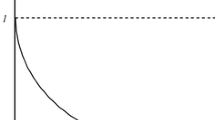Abstract
A number of problems of the optimal organization for revenue collection and law enforcement inspections are considered: the selection of agents for the primary and repeated audit, the salaries and rewards of inspectors at different levels, and the total number of levels in the hierarchy. In each case, the optimal strategy for the organization of an inspection is determined depending on the parameters used.
Similar content being viewed by others
References
INDEM Fund. How Many Times Does Corruption Rise within 4 Years: Results of New Research of INDEM Fund (2005) Available from http://www.indem.ru/corrupt/2005diag_press.htm
Transparency International. 2006 Corruption Perceptions Index, Available from http://www.transparency.org/news_room/in_focus/2006/cpi_2006/cpi_table
A. A. Vasin, Noncooperative Games in the Nature and Society (Maks Press, Moscow, 2005) [in Russian].
A. A. Vasin and V. V. Morozov, Game Theory and the Models of Mathematical Economics (MAKS Press, Moscow, 2005) [in Russian].
A. A. Vasin and E. I. Panova, Taxes Rising and Corruption in Fiscal Authorities (RPEI, Moscow, 2000) [in Russian].
J. F. Reinganum and L. L. Wilde, “Income Tax Compliance in a Principle-Agent Framework,” J. Publ. Econ. 26, 1–18 (1985).
K. Border and J. Sobel, “Samurai Account: A Theory of Auditing and Plunder,” Rev. Econ. Studies 54, 525–540 (1987).
Anticorruption Policy. Student’s Book, Ed. by G. A. Satarov (INDEM, Moscow, 2004) [in Russian].
M. I. Levin and M. L. Tsirik, “Mathematical Simulation of Corruption,” Ekon. Mat. Metody 34(4) (1998).
P. Chander and L. Wilde, “Corruption in Tax Administration,” J. Publ. Econ. 49(3), 333–349 (1992).
J. Hindrix, M. Keen, and A. Muthoo, “Corruption, Extortion and Evasion,” J. Publ. Econ. 74(3), 395–430 (1998).
D. Acemoglu and T. Verdier, “The Choice Between Market Failures and Corruption,” Am. Econ. Rev. 90(1), 194–211 (2000).
S. K. Kovbasyuk and M. I. Levin, Handbook on Course “Corruption Economy” (RESh, Moscow, 2007) [in Russian].
J. F. Reinganum and L. L. Wilde, “Income Tax Compliance in a Principle-Agent Framework,” J. Publ. Econ. 26, 1–18 (1985).
Author information
Authors and Affiliations
Additional information
Original Russian Text © A.A. Vasin, P.A. Kartunova, A.S. Urazov, 2010, published in Matematicheskoe Modelirovanie, 2010, Vol. 22, No. 4, pp. 67–89.
Rights and permissions
About this article
Cite this article
Vasin, A.A., Kartunova, P.A. & Urazov, A.S. Models for the organization of state inspections and the struggle against corruption. Math Models Comput Simul 2, 760–775 (2010). https://doi.org/10.1134/S2070048210060116
Received:
Published:
Issue Date:
DOI: https://doi.org/10.1134/S2070048210060116




